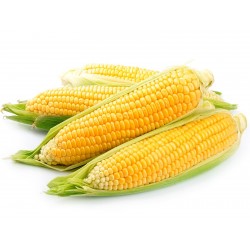Menu
-
MenuBack
- Home
-
Categories
-
-
Categories
-
Vegetable Seeds
-
Varieties by Country
- Varieties from Armenia
- Varieties from BiH
- Varieties from Croatia
- Varieties from France
- Varieties from Germany
- Varieties from Greece
- Varieties from Hungary
- Varieties from India
- Varieties from Italy
- Varieties from Japan
- Varieties from North Macedonia
- Varieties from Peru
- Varieties from Russia
- Varieties from Serbia
- Varieties from Slovenia
- Varieties from Spain
- Varieties from Thailand
- Varieties from Turkey
- Varieties from USA
- Tomato Seeds
- Corn Seeds
- Gourd family
- Bean family
- Cucumber Seeds
- Pepper Seeds
- Carrot family
- Onion family
- Lettuce Seeds
- Potato family
- Cabbage family
- Radish Seeds
- Beetroot family
- Watermelon Seeds
- Melon Seeds
- Cauliflower Seeds
- Sunflower family
-
Varieties by Country
- Fruit Seeds
- Chili - Habanero Seeds
- Medicinal Herb Seeds
- Climbing Plants Seeds
- Trees Bonsai Seeds
- Palm Seeds
- Ornamental Grasses Seeds
- Tobacco Seeds
-
Vegetable Seeds
-
-
-
-
- NEW PRODUCTS
- Create account
- Delivery - Payment
- FAQ
- Vegetable Seeds
-
- Varieties by Country
- Varieties from Armenia
- Varieties from BiH
- Varieties from Croatia
- Varieties from France
- Varieties from Germany
- Varieties from Greece
- Varieties from Hungary
- Varieties from India
- Varieties from Italy
- Varieties from Japan
- Varieties from North Macedonia
- Varieties from Peru
- Varieties from Russia
- Varieties from Serbia
- Varieties from Slovenia
- Varieties from Spain
- Varieties from Thailand
- Varieties from Turkey
- Varieties from USA
- Tomato Seeds
- Corn Seeds
- Gourd family
- Bean family
- Cucumber Seeds
- Pepper Seeds
- Carrot family
- Onion family
- Lettuce Seeds
- Potato family
- Cabbage family
- Radish Seeds
- Beetroot family
- Watermelon Seeds
- Melon Seeds
- Cauliflower Seeds
- Sunflower family
- Varieties by Country
Last Product Reviews
Out of the two seeds, one germinated and the other one was dead and floatin...
By
 Riikka H on 07/03/2024
Riikka H on 07/03/2024
Verified Purchase
There are 817 products.
Showing 46-60 of 817 item(s)

Coming Soon
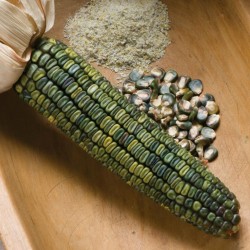
Green Sweetcorn Seeds...
Price
€1.95
(SKU: VE 181)
Seeds Gallery EU,
5/
5
<!DOCTYPE html>
<html>
<head>
<meta http-equiv="Content-Type" content="text/html; charset=UTF-8" />
</head>
<body>
<h2><strong>Green Sweetcorn Seeds Oaxacan Green</strong></h2>
<h2><span style="color: #ff0000;"><strong>Price for Package of 10 seeds.</strong></span></h2>
<p><span style="color: #000000;">This emerald maize has been grown for centuries by the Zapotec Indians of southern Mexico where it is used to make green flour tamales. Traditionally grown with squash and beans which climb up the corn stalks, this corn grows up to 7 feet tall and produces multiple 10-inch cobs on each stalk. Drought resistant and sturdy plants are green in color and yield white cobs that soon become rich green as they mature.</span></p>
<p><span style="color: #000000;">Eat the corn while it is still light in color as sweet corn or waits until it is mature to harvest as a flour corn. Brilliant green cobs are more than extraordinary in arrangements and can be ground to produce scrumptious jade tamales, cornbreads, or tortillas. </span></p>
</body>
</html>
VE 181 (10 S)

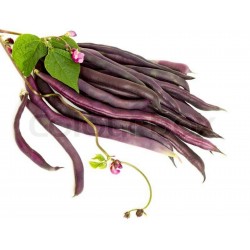
Runner Bean Cosse Violet Seeds
Price
€2.50
(SKU: VE 6 (7g))
Seeds Gallery EU,
5/
5
<h2><span style="text-decoration:underline;"><em><strong>Climbing French Bean Cosse Violet Seeds</strong></em></span></h2>
<h3><span style="color:#ff0000;"><strong>Price for Package of 20 seeds.</strong></span></h3>
<div>1868 (Vilmorin). "Plant of free vigorous growth, pods 6 to 8 inches long, twisted, of a deeppurplish blue colour. A very heavy cropper; very striking on account of the colour of its pods. A good edible-podded variety and very tender. The pods lose the purple colour on being cooked and become as green as others. Proceedings of the RHS 1895.</div>
VE 6 (7g)

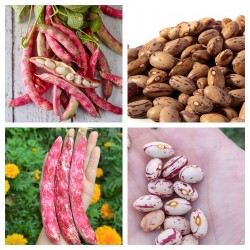
Climbing French Bean Seeds...
Price
€1.80
(SKU: VE 7 (8g))
Seeds Gallery EU,
5/
5
<h2 class=""><strong>Climbing French Bean Seeds 'Borlotto'</strong></h2>
<h2><span style="color: #ff0000;" class=""><strong>Price for Package of 15 (8g) seeds.</strong><strong><br></strong></span></h2>
<div>This variety of Climbing Beans has flat Red and Green pods. They can be used whole like Runner Beans or shelled to give dry beans. When cooked the Pods lose the Red coloration and are a pure Green. For dry beans, the pods should be left on the plant until they are similar in color to the picture with this listing. Whole pods for cooking should be taken when the pods are have developed the red markings but the outer skin has not hardened. </div>
<h3>Cultivation</h3>
<div>Sow the seeds from Feb (under glass) until April</div>
<div>Min Germination temp 16 deg C</div>
<div>Begin planting out in May once all risk of frost has passed.</div>
<div>A well cultivated free draining moist soil suits the plants best.</div>
<div>The addition of some well rotted manure prior to planting out will encourage the plants.</div>
<div>A fortnightly feed with a 'Tomato' based liquid feed will help to improve harvest.</div>
<script src="//cdn.public.n1ed.com/G3OMDFLT/widgets.js"></script>
VE 7 (8g)

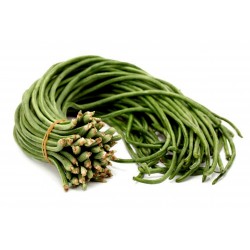
Yard Long Bean, Snake Bean,...
Price
€2.25
(SKU: VE 79 (1.9g))
Seeds Gallery EU,
5/
5
<meta http-equiv="Content-Type" content="text/html; charset=UTF-8"><h2><strong>Yard Long Bean, Snake Bean, Chinese Long Bean Seeds</strong></h2><h2><span style="color: #ff0000;" data-mce-style="color: #ff0000;" class="n1ed--selected"><strong>Price for Package of 10-15 (1,9g) seeds.</strong></span></h2><p><strong style="font-size: 14px;" data-mce-style="font-size: 14px;">Yard Long Bean also known as Snake Bean, Asparagus Bean or Chinese Long Bean produces long, thin round bean pods with a slightly sweet taste. The pods can grow up to 100cm long but are at their best picked when about 30cm long and the thickness of a pencil, then they will be tender and sweet rather than tough.</strong></p><p>Yard Long Beans are best grown under the protection of a polytunnel/greenhouse in the UK although they can be grown outside in a long hot summer. It is a climbing bean that can reach 2m tall so will need a frame or wigwam of poles to climb up and tied to as with Runner beans or French Beans.</p><p>Yard Long Bean produces pretty delicate purple flowers and the pods hang down in pairs. To keep them producing beans, regularly pick and use the bean fresh within 1-2 days. They are a very productive plant given the protection of a greenhouse and lots of heat although can be held back if a little cold.</p><p>Yard Long Beans are a staple of South East Asian/Thailand cuisine but are also used in Hindi (Chori) and Caribbean (bora) cooking. They can be steamed or stir-fried and are great in curries. Cut the pods into 10cm lengths and treat like French Beans. If any of the pods are allowed to mature, the beans in the pods can be shelled, dried and kept in an airtight container for use in soups and stews etc. The beans will require soaking overnight in water and boiling vigorously for 10 minutes before simmering until tender so as to destroy any toxins as with most pulses.</p><p>Yard Long Bean is an unusual bean that is well worth growing, but to get the best pick young and tender and use fresh but perhaps allow a couple to grow on have a competition to try growing the longest pod. It’s a bean feast!</p><p><br></p><div><span style="font-size: 10pt; color: #0000ff;" data-mce-style="font-size: 10pt; color: #0000ff;"><strong><span contenteditable="false" data-mce-object="iframe" class="mce-preview-object mce-object-iframe" data-mce-p-class="embed-responsive-item" data-mce-p-frameborder="0" data-mce-p-src="https://www.youtube.com/embed/CyDsxnUGO90?rel=0&hd=1" data-mce-html="%A0"><div class="n1ed_cover" data-cke-hidden-sel="true" contenteditable="false" style="z-index:200;left:0px;top:0px;width:640px;height:385px"></div><iframe src="https://www.youtube.com/embed/CyDsxnUGO90?rel=0&hd=1" class="embed-responsive-item" width="640" height="385" frameborder="0"></iframe><span class="mce-shim"></span></span></strong></span></div>
VE 79 (1.9g)


Giant plant (with giant fruits)
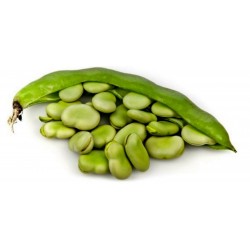
Fava Beans Seeds
Price
€2.55
(SKU: VE 162)
Seeds Gallery EU,
5/
5
<h2><strong>Broad Bean Aquadulce Fava Beans Seeds (Vicia faba)</strong></h2>
<h2><span style="color: #ff0000;" class=""><strong>Price for Package of 10 (16g) seeds. </strong></span></h2>
<div>Hardy Annual. Aquadulce is highly prolific and easy to grow, and yet remains one of the most delicious in terms of flavour and texture. It is a white seeded variety; with pods up to 23cm (9in) long, crops in 90 days with a height of 90 to 100cm (36 to 40in). They are an ideal variety for children to grow. This variety is universally recognised as being best hardy broad bean for an autumn sowing; it can be sown anytime from autumn until spring. It establishes itself very quickly and will produce a very early crop. We should, of course, all grow Broad Beans, as they are so much more delicious eaten young and just picked. When they're smaller than a thumbnail, you can even eat them raw. But it does take cooking - albeit just two minutes in lightly salted simmering water to bring out maximum sweetness. The first pick of the year, tossed with a slightly overindulgent knob of butter, is a high point of early summer.</div>
<div> </div>
<div>Broad Bean “Aquadulce” has been awarded the RHS Award of Garden Merit</div>
<div>It is also recommended by the River Cottage Handbook Veg Patch. </div>
<div> </div>
<div><strong>Sowing</strong></div>
<div>For the earliest crops sow from early autumn to late winter or sow in spring</div>
<div>Broad beans are best suited to a cool climate, and they only grow satisfactorily at temperatures below 15*C (60*F).</div>
<div>If sowing in the autumn, choose a sheltered position. The ideal soil is one which has been manured for a previous crop.</div>
<div> </div>
<div><strong>Direct sowing:</strong></div>
<div>Broad beans are traditionally sow in double rows 7cm (2in.) deep, 23cm (9in.) apart in the row.</div>
<div>The double rows should be spaced 23cm (9in.) apart and a distance of 40-60cm (18-24in.) should be left before the next set of double rows.</div>
<div>Plant seed 5cm deep. They should be planted or thinned to 20cm apart in staggered rows 30cm apart. Sow extra seeds at the end of the row for transplants. </div>
<div> </div>
<div><strong>Support</strong></div>
<div>As the beans get taller, you will need to provide extra support to your plants. A common mistake of the first-time gardener is not giving plants support ties that allow growing space. The haulm (stalk) of the broad bean plant is very brittle and easily broken, so the best way to support the plant is to construct a narrow box of stakes pegged in at 120cm intervals. Twist lengths of string from stake to stake to create a supporting frame that the bean plants can lean against when being blown around by the winter winds. Further levels of string can be added as the beans grow taller.</div>
<div> </div>
<div><strong>Care</strong></div>
<div>Once the pods start to form, ensure the beans are well watered around the base of the plant during dry periods. If the plants send out side shoots from the base, these should be cut off. At the end of cropping the plants should be removed from the soil. If the plants are left in the ground after their work is done, young sucker shoots can emerge which will exhaust the soil for follow-on crops.</div>
<div> </div>
<div><strong>Pinching out</strong></div>
<div>One of the gardening formalities with broad beans - undertaken when the flowers have just wilted to black, sooty curls and the first tiny pods are about to appear in their place - is to pinch out the little cluster of leaves at the top of the plant. This arrests further growth, directing the energy of the plant into the developing pods.</div>
<div>Don't discard these leafy bean tops - stir-fried in butter until lightly wilted, they are a delicious vegetable side dish in their own right - think of them as beany greens. They are also a fine filling for a tart or omelette.</div>
<div> </div>
<div><strong>Harvesting:</strong></div>
<div>8 to 10 weeks from spring sowing. Regular picking (ideally 2 or 3 times a week) will keep production going for about 4-6 weeks</div>
<div>For the best flavour, pick the beans when they are starting to show through the pod while the scar on the end of the beans is still white or green (although they can still be enjoyed after the scar has turned black). To remove the pods from the plant, give them a sharp twist in a downward direction.</div>
<div>With the last pick of the summer, the fat, bulging pods need a good 10 minutes boiling, after which the tender green kernels can be slipped out of their pale, leathery skins.</div>
<div> </div><script src="//cdn.public.n1ed.com/G3OMDFLT/widgets.js"></script>
VE 162 10 S


Giant plant (with giant fruits)

Variety from Greece
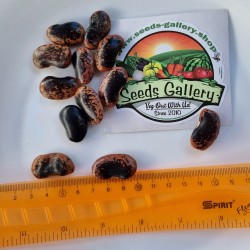
Fasolia Gigantes -...
Price
€2.45
(SKU: VE 220)
Seeds Gallery EU,
5/
5
<h2><strong>Fasolia Gigantes - Elefantes Kastorias Beans Seeds</strong></h2>
<h2 class=""><span style="color: #f80000;"><strong>Price for Package of 10 (20g) seeds.</strong></span></h2>
<div>Greek "Gigandes" beans for culinary use. The Greek giant beans are a traditional Greek food, used in several Greek gourmet recipes, such as bean soup, baked beans in the oven (butter beans), Greek salad, etc. Undoubtedly they are healthy, natural food and favorably place themselves in a Mediterranean diet.</div>
<div>
<p>Traditionally, gigandes plaki are served as a meze alongside other side dishes. However, this dish is filling enough to be eaten for lunch. This hearty meze is popular during the cold fall and winter months. As with many Greek dishes, bread is used to dip into the tomato sauce drippings.</p>
</div>
<div>Overall, gigandes plaki is healthy and nutritious food. It is a rich source of antioxidants from the tomatoes, and fiber from the other vegetables, and is suitable for vegetarians and vegans if the sausages and cheese are excluded.</div>
<h3><strong>These beans are 100% natural, this is not a hybrid or mutant product. </strong></h3>
<script src="//cdn.public.n1ed.com/G3OMDFLT/widgets.js"></script>
VE 220 (20g)

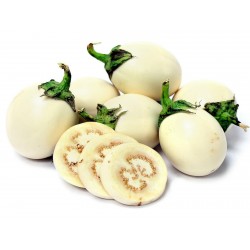
Eggplant Golden Eggs Seeds...
Price
€1.85
(SKU: VE 106)
Seeds Gallery EU,
5/
5
<h2><strong>Eggplant Golden Eggs Seeds (Solanum melongena)</strong></h2>
<h2><span style="color: #ff0000;"><strong>Price for Package of 10 or 25 seeds.</strong></span></h2>
<p>An unusual beautiful ornamental pot plant and/or annual, Golden Eggs' is sure to draw a lot of attention. This easy-to-grow plant reaches 12-20 inches tall and produces purple flowers and egg-shaped, non-edible, non-poisonous fruit. The fruit change from white to yellow and remain on the plant for weeks under proper environmental conditions.</p>
<p>'Golden Eggs' thrives in a warm to a hot environment and does best in full sun. Can be grown outside as an annual in a warm sunny sheltered location, but best in a conservatory/outside for the summer. Plants can be pinched, pruned or sheared depending on how they are used, including pot plants, large tubs or containers.</p>
<div><span style="font-size: 12pt;"> <span style="color: #0000ff;"><strong><a href="http://www.youtube.com/watch?v=4NLJ-1bvhxM&feature=youtu.be" target="_blank" rel="noreferrer noopener"><span style="color: #0000ff;">http://www.youtube.com/watch?v=4NLJ-1bvhxM&feature=youtu.be</span></a></strong></span></span></div>
<div>· Sow thinly in good quality well drained seed compost, covering thinly and keeping moist at 65-70F.</div>
<div>· Germination in 7-14 days.</div>
<div>· Transplant seedlings to individual pots after 6-10 weeks</div>
<div>· Golden Eggs' is a moderate feeder and should be fertilized at every other watering.</div>
<div>· Prune as required to keep in shape.</div>
VE 106 (10 S)


This product is best seller product
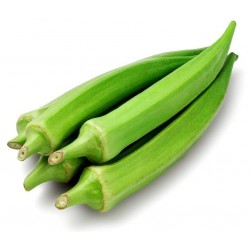
Okra Seeds Clemson...
Price
€1.35
(SKU: VE 8 G (1g))
Seeds Gallery EU,
5/
5
<h2><strong>Okra Seeds Clemson Spineless</strong></h2>
<h2><span style="color: #ff0000;" class=""><strong>Price for Package of 1g (+-15) seeds.</strong></span></h2>
<div>This variety is one of the most popular, prolific and reliable strains available. Straight, 6-7 inch, green pods are slightly ridged and definitely spineless. Plants 3 ft. high, produce an abundance of dark green, 6-inch slightly tapered and ribbed, straight, pointed pods without spines. Best when 2 1/2-3 in. long. Fine quality and prolific. First harvest around 60 days after seed is sown. </div>
<div>Days to Germination: 10-14</div>
<div>Days To Harvest: 55-65</div>
<div>Planting Depth: 1/2 - 3/4 in.</div>
<div>Spacing, Row: 3 foot</div>
<div>Plant Height: 3 ft.</div>
<div>Light: Full Sun</div>
<div>Sow under cover 4-6 weeks before last frost or directly outside in warmer areas from late spring.</div>
<div>Sow 1/2-3/4 inch deep, 2 to a pot and thin to strongest seedling, or thinly in rows, thinning to 18-24 inches between plants.</div>
<div>Plant out after last frost.</div>
<div>Sunny location required in order to maximise harvest.</div>
<div>Harvest pods when they are young and tender, 2 1/2 - 3 inches long. </div>
<div>Keep ripe pods picked to encourage production.</div>
<div>showing.</div>
<div>Harvest the beans when the pods are well fat and the seed still soft.</div>
<script src="//cdn.public.n1ed.com/G3OMDFLT/widgets.js"></script>
VE 8 G (1g)


Variety from Serbia
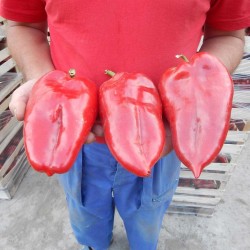
Elephant's Ear Sweet Pepper...
Price
€2.15
(SKU: PP 56)
Seeds Gallery EU,
5/
5
<h2><strong>"Elephant's Ear" Sweet Pepper Seeds</strong></h2>
<h2><span style="color: #ff0000;" class=""><strong>Price is for package of 50 seeds.</strong><strong><br /></strong></span></h2>
<p>Big fruity, aromatic. Elephant ear is one of the favorite Serbian varieties in Serbia, it is mostly used for making "<span style="text-decoration: underline;"><a href="https://en.wikipedia.org/wiki/Ajvar" target="_blank" rel="noopener"><strong>ajvar</strong></a></span>", "pinđur", stuffing as well as for deep freezing. They can be used well for pickling, for grilling, in vegetable dishes, in meat dishes, and as a salad.</p>
<p>Excellent in taste.</p>
<p>Elephant's Ear is sweet pepper, with very large and fleshy fruits. The color of the fruit changes from dark green to bright red when ripe. Reaches a weight of 150-350gr. It is very disease resistant and provides a stable yield of 50/60 tons per acre. This variety is suitable for the greenhouse, for cold frames, and also for outdoors.</p>
<p><strong>Big package of elephant ears pepper you can buy here: <span style="font-size: 12pt;"><a href="https://www.seeds-gallery.shop/en/home/paprika-elephant-s-ear-1100-seeds.html" target="_blank" rel="noreferrer noopener"><span style="color: #ff0000;">Click here</span></a></span></strong></p>
<p>Capsicum (/ˈkæpsɪkəm, also known as peppers) is a genus of flowering plants in the nightshade family Solanaceae. Its species are native to the Americas, where they have been cultivated for thousands of years. Following the Columbian Exchange, it has become cultivated worldwide, and it has also become a key element in many cuisines. In addition to use as spices and food vegetables, Capsicum species have also been used as medicines and lachrymatory agents.<br /><br /><strong>Etymology and names</strong><br />The generic name may come from Latin capsa 'box', presumably alluding to the pods or the Greek word κάπτω kapto 'to gulp'.[4][5][6] The name "pepper" comes from the similarity of the flavor to black pepper, Piper nigrum, although there is no botanical relationship with it or with Sichuan pepper. The original term, chilli (now chile in Mexico) came from the Nahuatl word chīlli, denoting a larger Capsicum variety cultivated at least since 3000 BC, as evidenced by remains found in pottery from Puebla and Oaxaca.<br /><br />The fruit of Capsicum plants have a variety of names depending on place and type. The piquant (spicy) varieties are commonly called chili peppers, or simply "chilis". The large, mild form is called "red (bell) pepper", "green (bell) pepper", or just "bell pepper" (depending on color) in North America and United Kingdom and typically "capsicum" in New Zealand,[8] Australia, Singapore and India. The fruit is called "paprika" in some other countries (although paprika can also refer to the powdered spice made from various capsicums).<br /><br /><strong>Growing conditions</strong><br />Ideal growing conditions for peppers include a sunny position with warm, loamy soil, ideally 21 to 29 °C (70 to 84 °F), that is moist but not waterlogged.[9] Extremely moist soils can cause seedlings to "damp-off" and reduce germination.<br /><br />The plants are sensitive to frost. For flowering, Capsicum is a non-photoperiod-sensitive crop. The flowers can self-pollinate. However, at extremely high temperature, 92 to 100 °F (33 to 38 °C), pollen loses viability, and flowers are much less likely to pollinate successfully.<br /><br /><strong>Species and varieties</strong><br />Capsicum consists of 20–27 species,[11] five of which are domesticated: C. annuum, C. baccatum, C. chinense, C. frutescens, and C. pubescens.[12] Phylogenetic relationships between species have been investigated using biogeographical,[13] morphological,[14] chemosystematic,[15] hybridization,[16] and genetic[11] data. Fruits of Capsicum can vary tremendously in color, shape, and size both between and within species, which has led to confusion over the relationships among taxa.[17] Chemosystematic studies helped distinguish the difference between varieties and species. For example, C. baccatum var. baccatum had the same flavonoids as C. baccatum var. pendulum, which led researchers to believe the two groups belonged to the same species.<br /><br />Many varieties of the same species can be used in many different ways; for example, C. annuum includes the "bell pepper" variety, which is sold in both its immature green state and its red, yellow, or orange ripe state. This same species has other varieties, as well, such as the Anaheim chiles often used for stuffing, the dried ancho (also sometimes referred to as poblano) chile used to make chili powder, the mild-to-hot jalapeño, and the smoked, ripe jalapeño, known as chipotle.<br /><br />Peru is thought to be the country with the highest cultivated Capsicum diversity since varieties of all five domesticates are commonly sold in markets in contrast to other countries. Bolivia is considered to be the country where the largest diversity of wild Capsicum peppers are consumed. Bolivian consumers distinguish two basic forms: ulupicas, species with small round fruits including C. eximium, C. cardenasii, C. eshbaughii, and C. caballeroi landraces; and arivivis, with small elongated fruits including C. baccatum var. baccatum and C. chacoense varieties.<br /><br />Most of the capsaicin in a pungent (hot) pepper is concentrated in blisters on the epidermis of the interior ribs (septa) that divide the chambers, or locules, of the fruit to which the seeds are attached.[19] A study on capsaicin production in fruits of C. chinense showed that capsaicinoids are produced only in the epidermal cells of the interlocular septa of pungent fruits, that blister formation only occurs as a result of capsaicinoid accumulation, and that pungency and blister formation are controlled by a single locus, Pun1, for which there exist at least two recessive alleles that result in non-pungency of C. chinense fruits.<br /><br />The amount of capsaicin in hot peppers varies significantly among varieties, and is measured in Scoville heat units (SHU). The world's current hottest known pepper as rated in SHU is the 'Carolina Reaper,' which had been measured at over 2,200,000 SHU.</p>
<div></div>
<div><strong>Genetics</strong><br />Most Capsicum species are 2n=2x=24. A few of the non-domesticated species are 2n=2x=32.[23] All are diploid. The Capsicum annuum and Capsicum chinense genomes were completed in 2014. The Capsicum annuum genome is approximately 3.48 Gb, making it larger than the human genome. Over 75% of the pepper genome is composed of transposable elements, mostly Gypsy elements, distributed widely throughout the genome. The distribution of transposable elements is inversely correlated with gene density. Pepper is predicted to have 34,903 genes, approximately the same number as both tomato and potato, two related species within the Solanaceae family.<br /><br /><strong>Breeding</strong><br />Many types of peppers have been bred for heat, size, and yield. Along with selection of specific fruit traits such as flavor and color, specific pest, disease and abiotic stress resistances are continually being selected. Breeding occurs in several environments dependent on the use of the final variety including but not limited to: conventional, organic, hydroponic, green house and shade house production environments.<br /><br />Several breeding programs are being conducted by corporations and universities. In the United States, New Mexico State University has released several varieties in the last few years.[25] Cornell University has worked to develop regionally adapted varieties that work better in cooler, damper climates. Other universities such as UC Davis, University of Wisconsin-Madison, and Oregon State University have smaller breeding programs. Many vegetable seed companies breed different types of peppers as well.<br /><br /><strong>Capsaicin in Capsicum.</strong><br />The fruit of most species of Capsicum contains capsaicin (methyl-n-vanillyl nonenamide), a lipophilic chemical that can produce a strong burning sensation (pungency or spiciness) in the mouth of the unaccustomed eater. Most mammals find this unpleasant, whereas birds are unaffected. The secretion of capsaicin protects the fruit from consumption by insects and mammals, while the bright colors attract birds that will disperse the seeds.<br /><br />Capsaicin is present in large quantities in the placental tissue (which holds the seeds), the internal membranes, and to a lesser extent, the other fleshy parts of the fruits of plants in this genus. The seeds themselves do not produce any capsaicin, although the highest concentration of capsaicin can be found in the white pith around the seeds.<br /><br />The amount of capsaicin in the fruit is highly variable and dependent on genetics and environment, giving almost all types of Capsicum varied amounts of perceived heat. The most recognizable Capsicum without capsaicin is the bell pepper, a cultivar of Capsicum annuum, which has a zero rating on the Scoville scale. The lack of capsaicin in bell peppers is due to a recessive gene that eliminates capsaicin and, consequently, the "hot" taste usually associated with the rest of the Capsicum family.[32] There are also other peppers without capsaicin, mostly within the Capsicum annuum species, such as the cultivars Giant Marconi, Yummy Sweets, Jimmy Nardello,[35] and Italian Frying peppers[36](also known as the Cubanelle).<br /><br />Chili peppers are of great importance in Native American medicine, and capsaicin is used in modern medicine—mainly in topical medications—as a circulatory stimulant and analgesic. In more recent times, an aerosol extract of capsaicin, usually known as capsicum or pepper spray, has become used by law enforcement as a nonlethal means of incapacitating a person, and in a more widely dispersed form for riot control, or by individuals for personal defense. Pepper in vegetable oils, or as an horticultural product[37] can be used in gardening as a natural insecticide.<br /><br />Although black pepper causes a similar burning sensation, it is caused by a different substance—piperine.</div>
<div></div>
<div><strong>Synonyms and common names</strong><br />The name given to the Capsicum fruits varies between English-speaking countries.<br /><br />In Australia, New Zealand, and India, heatless varieties are called "capsicums", while hot ones are called "chilli"/"chillies" (double L). Pepperoncini are also known as "sweet capsicum". The term "bell peppers" is almost never used, although C. annuum and other varieties which have a bell shape and are fairly hot, are often called "bell chillies".<br /><br />In Ireland and the United Kingdom, the heatless varieties are commonly known simply as "peppers" (or more specifically "green peppers", "red peppers", etc.), while the hot ones are "chilli"/"chillies" (double L) or "chilli peppers".<br /><br />In the United States and Canada, the common heatless varieties are referred to as "bell peppers", "sweet peppers", "red/green/etc. peppers", or simply "peppers", additionally in Indiana they may be referred to as "mangoes/mango peppers", while the hot varieties are collectively called "chile"/"chiles", "chili"/"chilies", or "chili"/"chile peppers" (one L only), "hot peppers", or named as a specific variety (e.g., banana pepper).<br /><br />In Polish and in Hungarian, the term papryka and paprika (respectively) is used for all kinds of capsicums (the sweet vegetable, and the hot spicy), as well as for dried and ground spice made from them (named paprika in both U.S. English and Commonwealth English). Also, fruit and spice can be attributed as papryka ostra (hot pepper) or papryka słodka (sweet pepper). The term pieprz (pepper) instead means only grains or ground black pepper (incl. the green, white, and red forms), but not capsicum. Sometimes, the hot capsicum spice is also called chilli.<br /><br />In Italy and the Italian- and German-speaking parts of Switzerland, the sweet varieties are called peperone and the hot varieties peperoncino (literally "small pepper"). In Germany, the heatless varieties as well as the spice are called Paprika and the hot types are primarily called Peperoni or Chili while in Austria, Pfefferoni is more common for these; in Dutch, this word is also used exclusively for bell peppers, whereas chilli is reserved for powders, and hot pepper variants are referred to as Spaanse pepers (Spanish peppers). In Switzerland, though, the condiment powder made from capsicum is called Paprika (German language regions) and paprica (French and Italian language region). In French, capsicum is called poivron or piment.<br /><br />In Spanish-speaking countries, many different names are used for the varieties and preparations. In Mexico, the term chile is used for "hot peppers", while the heatless varieties are called pimiento (the masculine form of the word for pepper, which is pimienta). Several other countries, such as Chile, whose name is unrelated, Perú, Puerto Rico, and Argentina, use ají. In Spain, heatless varieties are called pimiento and hot varieties guindilla. Also, in Argentina and Spain, the variety C. chacoense is commonly known as "putaparió", a slang expression equivalent to "damn it", probably due to its extra-hot flavour.<br /><br />In Indian English, the word "capsicum" is used exclusively for Capsicum annuum. All other varieties of hot capsicum are called chilli. In northern India and Pakistan, C. annuum is also commonly called shimla mirch in the local language and as "Kodai Mozhagai" in Tamil which roughly translates to "umbrella chilli" due to its appearance. Shimla, incidentally, is a popular hill-station in India (and mirch means chilli in local languages).<br /><br />In Japanese, tōgarashi (唐辛子, トウガラシ "Chinese mustard") refers to hot chili peppers, and particularly a spicy powder made from them which is used as a condiment, while bell peppers are called pīman (ピーマン, from the French piment or the Spanish pimiento).</div>
<script src="//cdn.public.n1ed.com/G3OMDFLT/widgets.js"></script>
PP 56 (50 S)

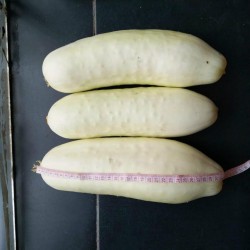
Cucumber Seeds White Wonder
Price
€1.80
(SKU: PK 14)
Seeds Gallery EU,
5/
5
<h2><strong>Cucumber Seeds White Wonder</strong></h2>
<h2><span style="color:#ff0000;"><strong>Price for Package of 10 seeds.</strong></span></h2>
<p>This classic cucumber was introduced by xxxxx in 1893. xxxxx introduced this now classic cucumber in 1893, after receiving it from a customer in western New York. Pale ivory, the 6-8"-long and 2-3"-wide fruits have an exceptionally crisp texture, making for excellent fresh eating or tasty pickles. Produces high yields, even in high heat. Harvest in 55-60 days.</p>
PK 14 (10 S)

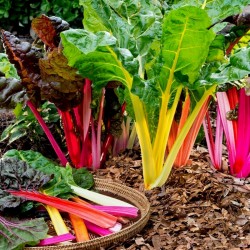
Swiss Chard Rainbow Seeds
Price
€1.90
(SKU: VE 11 (1g))
Seeds Gallery EU,
5/
5
<!DOCTYPE html>
<html>
<head>
<meta http-equiv="Content-Type" content="text/html; charset=UTF-8" />
</head>
<body>
<h2><strong>Swiss Chard Rainbow Seeds</strong></h2>
<h2><span style="color: #ff0000;"><strong>Price for Package of 55+- (1g) seeds.</strong></span></h2>
<p>Rainbow chard, which is extremely popular not only because of its rich colors! Remains a bit smaller than the white Swiss chard, but is more resistant and withstands winter protection even when planted outdoors. The outer leaves are harvested, if the weather permits, this can be done until the end of November. The stems can be cooked or steamed as vegetables, the young leaves are also for raw consumption e.g. best suited in salads. Because of its color, it is also a real eye-catcher as a decorative plant in the perennial border. It should be in a sunny location on freshly moist soil.</p>
<p>Origin: France</p>
<p>Ripening time: 70 days (medium early)</p>
<p>Leaves: medium to 40 cm</p>
<p>Plant height: 50 cm</p>
</body>
</html>
VE 11 (1g)

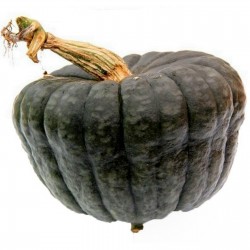
Pumpkin seeds Queensland Blue
Price
€2.05
(SKU: VG 44)
Seeds Gallery EU,
5/
5
<h2><strong>Pumpkin seeds Queensland Blue</strong></h2>
<h2><span style="color:#ff0000;"><strong>Price for Package of 10 seeds.</strong></span></h2>
<div>This popular <strong>Australian heirloom</strong> was introduced to the US in 1932 and is sometimes called the Australian Blue Pumpkin. The Queensland Blue Squash is a striking blue colored, turban shaped fruit with a flavorful, sweet golden colored flesh. It is a great tasting roasting pumpkin or can be used in soups. This squash produces fruits weighing 5-13 kg. Queensland Blue Squash squash stores well and can be stored in a cool, dry location for 1-6 months.</div>
VG 44 O (10 S)

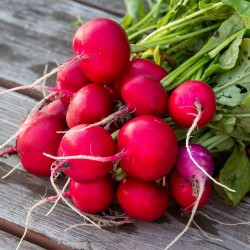
Radish Saxa Treib Seeds
Price
€1.25
(SKU: VE 12 (1g))
Seeds Gallery EU,
5/
5
<h2><strong>Radish Saxa Treib Seeds (Raphanus sativus)</strong></h2>
<h2 class=""><span style="color: #ff0000;"><strong>Price for Package of 1g (100) seeds.</strong></span></h2>
<div>An early, sweet variety of radish producing brilliant red, round roots which will stay crisp over a long period. The radish (Raphanus sativus) is an edible root vegetable of the Brassicaceae family that was domesticated in Europe, in pre-Roman times. They are grown and consumed throughout the world. Radishes have numerous varieties, varying in size, color and duration of required cultivation time. There are some radishes that are grown for their seeds; oilseed radishes are grown, as the name implies, for oil production. Radish can sprout from seed to small plant in as little as 3 days.</div>
<div> </div>
<div><strong>History</strong></div>
<div>The descriptive Greek name of the genus Raphanus means "quickly appearing" and refers to the rapid germination of these plants. Raphanistrum, from the same Greek root, is an old name once used for this genus. The common name "radish" is derived from Latin radix (root). The radish has been used over many centuries.</div>
<div>Although the radish was a well-established crop in Hellenistic and Roman times, which leads to the assumption that it was brought into cultivation at an earlier time, Zohary and Hopf note that "there are almost no archeological records available" to help determine its earlier history and domestication. Wild forms of the radish and its relatives, the mustards and turnip, can be found over west Asia and Europe, suggesting that their domestication took place somewhere in that area. However Zohary and Hopf conclude, "Suggestions as to the origins of these plants are necessarily based on linguistic considerations."</div>
<div></div>
<div><strong>Cultivation</strong></div>
<div><strong>Growing radish plants</strong></div>
<div>Radishes grow best in full sun and light, sandy loams with pH 6.5–7.0. They are in season from April to June and from October to January in most parts of North America; in Europe and Japan they are available year-round due to the plurality of varieties grown.</div>
<div>Summer radishes mature rapidly, with many varieties germinating in 3–7 days, and reaching maturity in three to four weeks. Harvesting periods can be extended through repeated plantings, spaced a week or two apart.</div>
<div>As with other root crops, tilling the soil to loosen it up and remove rocks helps the roots grow. However, radishes are used in no-till farming to help reverse compaction.</div>
<div>Most soil types will work, though sandy loams are particularly good for winter and spring crops, while soils that form a hard crust can impair growth. The depth at which seeds are planted affects the size of the root, from 1 cm (0.4 in) deep recommended for small radishes to 4 cm (1.6 in) for large radishes.</div>
<div>Radishes are a common garden crop in the U.S., and the fast harvest cycle makes them a popular choice for children's gardens.</div>
<div>In temperate climates, it's customary to plant radishes every two weeks from early spring until a few weeks before the first frost, except during periods of hot weather. In warm-weather climates, they are normally planted in the fall.</div>
<div>Companion plant</div>
<div>Radishes serve as companion plants for many other species, because of their ability to function as a trap crop against pests like flea beetles. These pests will attack the leaves, but the root remains healthy and can be harvested later.</div>
<div></div>
<div><strong>Varieties</strong></div>
<div>Broadly speaking, radishes can be categorized into four main types (summer, fall, winter, and spring) and a variety of shapes lengths, colors, and sizes, such as red, pink, white, gray-black or yellow radishes, with round or elongated roots that can grow longer than a parsnip.</div>
<div></div>
<div>Spring or summer radishes</div>
<div>European radishes (Raphanus Sativus)</div>
<div>Sometimes referred to as European radishes or spring radishes if they're planted in cooler weather, summer radishes are generally small and have a relatively short 3–4 week cultivation time.</div>
<div></div>
<div>The April Cross is a giant white radish hybrid that bolts very slowly.</div>
<div></div>
<div>Bunny Tail is an heirloom variety from Italy, where it is known as 'Rosso Tondo A Piccola Punta Bianca'. It is slightly oblong, mostly red, with a white tip.</div>
<div></div>
<div>Cherry Belle is a bright red-skinned round variety with a white interior. It is familiar in North American supermarkets.</div>
<div></div>
<div>Champion is round and red-skinned like the Cherry Belle, but with slightly larger roots, up to about 5 cm (2 in), and a milder flavor.</div>
<div>Red King has a mild flavor, with good resistance to club root, a problem that can arise from poor drainage.</div>
<div></div>
<div>Sicily Giant is a large heirloom variety from Sicily. It can reach up to two inches in diameter.</div>
<div>Snow Belle is an all-white variety of radish, similar in shape to the Cherry Belle.</div>
<div>White Icicle or just Icicle is a white carrot-shaped variety, around 10–12 cm (4–5 in) long, dating back to the 16th century. It slices easily, and has better than average resistance to pithiness.</div>
<div>French Breakfast is an elongated red-skinned radish with a white splash at the root end. It is typically slightly milder than other summer varieties, but is among the quickest to turn pithy.</div>
<div>Plum Purple a purple-fuchsia radish that tends to stay crisp longer than average.</div>
<div>Gala and Roodbol are two varieties popular in the Netherlands in a breakfast dish, thinly sliced on buttered bread.</div>
<div></div>
<div>Easter Egg is not an actual variety, but a mix of varieties with different skin colors,[6] typically including white, pink, red, and purple radishes. Sold in markets or seed packets under the name, the seed mixes can extend harvesting duration from a single planting, as different varieties may mature at different times.</div>
<div></div>
<div>Winter varieties</div>
<div>Daikon</div>
<div>Black Spanish or Black Spanish Round occur in both round and elongated forms, and are sometimes simply called the black radish or known by the French name Gros Noir d'Hiver. It dates in Europe to 1548, and was a common garden variety in England and France during the early 19th century. It has a rough black skin with hot-flavored white flesh, is round or irregularly pear shaped, and grows to around 10 cm (4 in) in diameter.</div>
<div>Daikon refers to a wide variety of winter radishes from Asia. While the Japanese name daikon has been adopted in English, it is also sometimes called the Japanese radish, Chinese radish, Oriental radish or mooli (in India and South Asia). Daikon commonly have elongated white roots, although many varieties of daikon exist. One well known variety is April Cross, with smooth white roots. The New York Times describes Masato Red and Masato Green varieties as extremely long, well suited for fall planting and winter storage. The Sakurajima daikon is a hot-flavored variety which is typically grown to around 10 kg (22 lb), but which can grow to 30 kg (66 lb) when left in the ground.</div>
<div></div>
<div>Seed pod varieties</div>
<div>Radish fruits, also called pods</div>
<div></div>
<div>Radish seeds</div>
<div>The seeds of radishes grow in siliques (widely referred to as "pods"), following flowering that happens when left to grow past their normal harvesting period. The seeds are edible, and are sometimes used as a crunchy, spicy addition to salads. Some varieties are grown specifically for their seeds or seed pods, rather than their roots. The Rat-tailed radish, an old European variety thought to have come from East Asia centuries ago, has long, thin, curly pods which can exceed 20 cm (8 in) in length. In the 17th century, the pods were often pickled and served with meat. The München Bier variety supplies spicy seed pods that are sometimes served raw as an accompaniment to beer in Germany.</div>
<div></div>
<div>Nutritional value</div>
<div>Radish, raw, root only</div>
<div>Nutritional value per 100 g (3.5 oz)</div>
<div>Energy 66 kJ (16 kcal)</div>
<div>Carbohydrates 3.40 g</div>
<div>- Sugars 1.86 g</div>
<div>- Dietary fiber 1.6 g</div>
<div>Fat 0.10 g</div>
<div>Protein 0.68 g</div>
<div>Thiamine (vit. B1) 0.012 mg (1%)</div>
<div>Riboflavin (vit. B2) 0.039 mg (3%)</div>
<div>Niacin (vit. B3) 0.254 mg (2%)</div>
<div>Pantothenic acid (B5) 0.165 mg (3%)</div>
<div>Vitamin B6 0.071 mg (5%)</div>
<div>Folate (vit. B9) 25 μg (6%)</div>
<div>Vitamin C 14.8 mg (18%)</div>
<div>Calcium 25 mg (3%)</div>
<div>Iron 0.34 mg (3%)</div>
<div>Magnesium 10 mg (3%)</div>
<div>Phosphorus 20 mg (3%)</div>
<div>Potassium 233 mg (5%)</div>
<div>Zinc 0.28 mg (3%)</div>
<div>Percentages are relative to</div>
<div>US recommendations for adults.</div>
<div>Source: USDA Nutrient Database</div>
<div>Radishes are rich in ascorbic acid, folic acid, and potassium. They are a good source of vitamin B6, riboflavin, magnesium, copper, and calcium. One cup of sliced red radish bulbs provides approximately 20 cal, largely from carbohydrates.</div>
<div></div>
<div>Uses</div>
<div>Cooking</div>
<div>The most commonly eaten portion is the napiform taproot, although the entire plant is edible and the tops can be used as a leaf vegetable. It can also be eaten as a sprout.</div>
<div>The bulb of the radish is usually eaten raw, although tougher specimens can be steamed. The raw flesh has a crisp texture and a pungent, peppery flavor, caused by glucosinolates and the enzyme myrosinase which combine when chewed to form allyl isothiocyanates, also present in mustard, horseradish, and wasabi.</div>
<div></div>
<div>Radish leaves are sometimes used in recipes, like potato soup or as a sauteed side dish. They are also found to benefit homemade juices; some recipes even calling for them in fruit based mixutres.</div>
<div>Radishes may be used in salads, as well as in many European dishes.</div>
<div></div>
<div>Industry</div>
<div>The seeds of the Raphanus sativus species can be pressed to extract seed oil. Wild radish seeds contain up to 48% oil content, and while not suitable for human consumption the oil is a potential source of biofuel. The oilseed radish grows well in cool climates.</div>
<div></div>
<div>Culture</div>
<div>Citizens of Oaxaca, Mexico, celebrate the radish in a festival called Noche de los Rábanos (Night of the Radishes) on December 23 as a part of Christmas celebrations. Locals carve religious and popular figures out of radishes and display them in the town square.</div>
<script src="//cdn.public.n1ed.com/G3OMDFLT/widgets.js"></script>
VE 12 (1g)


Variety from Italy
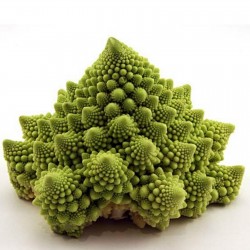
Romanesco Cauliflower Seeds
Price
€2.15
(SKU: VE 13)
Seeds Gallery EU,
5/
5
<h2><strong>Romanesco Cauliflower Seeds</strong></h2>
<h2><span style="color: #ff0000;"><strong>Price for a Package of 50 seeds.</strong></span></h2>
<p>Romanesco cauliflowers are a fantastic variety from Italy, producing stunning yellow green heads of spiral rosettes with an excellent flavor visually that resemble a pine cone. Many Romanesco cauliflowers are spring maturing but this rare one that comes ready in the autumn (Oct-Nov), thus avoiding the need to overwinter it.</p>
<p>Start indoors in a warm, well-lighted area from early March through June for the earliest of crops. Sow seeds ¼" deep in good compost. Keep evenly moist. Seedlings emerge in 5-8 days at 70º F. They do best covered lightly with soil. Alternatively, sow directly outside from early April.</p>
<p>Transplant seedlings by at least Midsummer. They grow best at 55º to 65º F. Do not let seedling become more than 5 weeks old because older seedlings do not mature well transplanted.</p>
<p>Set plants 18" apart in rows 24" apart. Transplant seedlings in late June for Oct - Nov head harvest.</p>
<p>Water deeply once a week in dry weather. Cultivate or mulch to control weeds. High fertility and abundant supply of water throughout the growing season are important</p>
<script src="//cdn.public.n1ed.com/G3OMDFLT/widgets.js"></script>
VE 13 (50 S)






